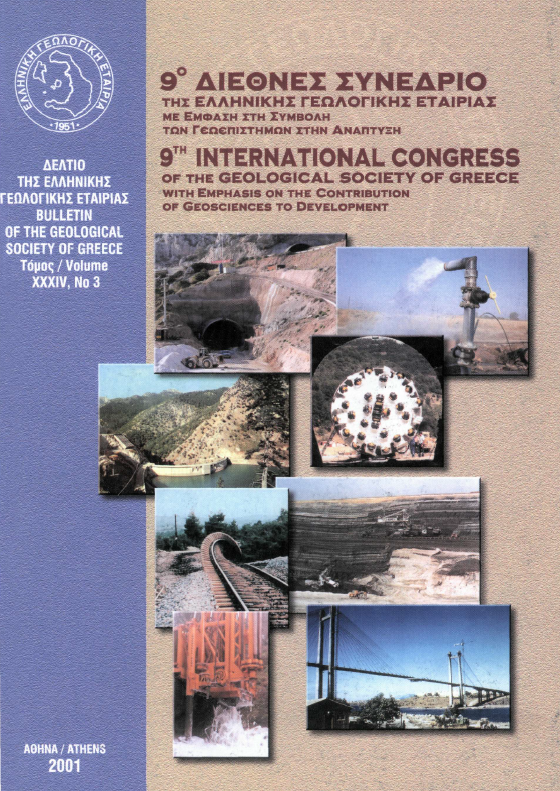PETROGRAPHIC AND GEOCHEMICAL RESEARCH OF THE CARBONATE ROCKS OF THE AREA OF VAFIOCHORI KILKIS
Résumé
According to the microscopic examination of thin sections, the examined carbonate rocks are classified in two categories: a. Typical marbles and b. Recrystallised limestones. Category b is distinguished in two sub-categories: Micrites (b1) and sparites (b2). Calcite is the predominant mineral in almost all samples, whereas only in one sample there is a considerable quantity of dolomite. From the unessential minerals quartz, plagioclastes, talc, muscovite and chlorite were identified in traces. It's concluded that nine samples are very pure carbonate rocks and consist of >96% CaC03. The sum of the admixtures, that is all the oxides except for CaO and CO2, ranges from 1,6 to 8,7%, from which the most important is the S1O2 (0,5-6,7%), mainly in the form of quartz and the MgO (0,3-3,6%). The increased participation of Ni2+, Co2+, Rb+ and Zn2 + in relation to the worldwide average, could be attributed to the presence of foreign admixtures which occur in the examined carbonate rocks. The limited participation of Sr2* could be attributed to the absence of feldspars from these carbonate rocks. The mean value of the insoluble residue is 3,1%. The mean value of the included organic matter is 0,3%. Testing the degree of the whiteness it comes out that only one sample is almost absolutely white. Two samples are in the spectrum of the orange color, whereas the hues of six samples are in the spectrum of orange-yellow color. According to the chemical composition of the samples it is concluded that:
• The samples from all the formations can be used for aggregates, because with the suitable breaking they can reach the requisite size for every use.
• The samples from all the formations can be suitable feedstock for soil conditioners, after suitable grinding, in order to take grain sizes <5 mm, because their content in MgO is < 5%.
• The samples from all the formations are considered to be ideal as feedstock in the cement industry, as long as the concentration of fluorine in them is < 0,1%.
• The examined formations can be partly used into other industrial sections. However, supplementary specialized tests are needed.
Article Details
- Comment citer
-
Ηλιάδου Σ., Τσιραμπίδης Α., Κασώλη-Φουρναράκη Α., & Μιχαηλίδης Κ. (2004). PETROGRAPHIC AND GEOCHEMICAL RESEARCH OF THE CARBONATE ROCKS OF THE AREA OF VAFIOCHORI KILKIS. Bulletin of the Geological Society of Greece, 36(1), 10–18. https://doi.org/10.12681/bgsg.16549
- Rubrique
- Industrial Minerals and Rocks

Ce travail est disponible sous licence Creative Commons Attribution - Pas d’Utilisation Commerciale 4.0 International.
Authors who publish with this journal agree to the following terms:
Authors retain copyright and grant the journal right of first publication with the work simultaneously licensed under a Creative Commons Attribution Non-Commercial License that allows others to share the work with an acknowledgement of the work's authorship and initial publication in this journal.
Authors are able to enter into separate, additional contractual arrangements for the non-exclusive distribution of the journal's published version of the work (e.g. post it to an institutional repository or publish it in a book), with an acknowledgement of its initial publication in this journal. Authors are permitted and encouraged to post their work online (preferably in institutional repositories or on their website) prior to and during the submission process, as it can lead to productive exchanges, as well as earlier and greater citation of published work.




